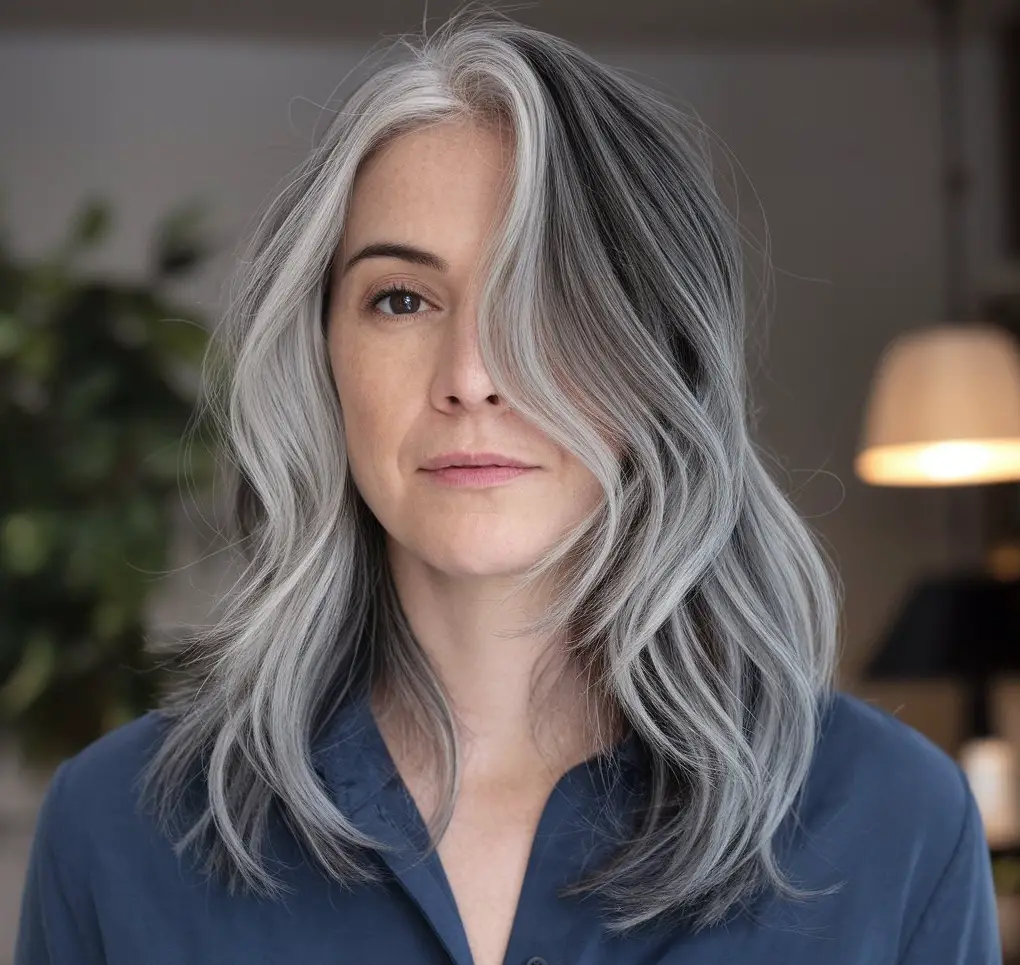Gray hair has become increasingly visible as more women choose to transition naturally rather than continuously covering their silver strands. The harsh line between gray roots and previously colored hair can create an unflattering contrast that makes the transition feel abrupt and unpolished. This stark demarcation often leaves women feeling self-conscious about their appearance during what should be a liberating journey toward natural beauty.
Gray hair blending offers an elegant solution that works with your natural color changes instead of fighting against them. This coloring technique seamlessly integrates your emerging silver strands with your existing hair tone, creating a sophisticated multi-dimensional look. Rather than completely masking gray hair, this approach enhances your natural graying process to produce a harmonious blend that feels intentional and modern.
The following sections will guide you through the best techniques for achieving flawless gray blending using highlights and lowlights. We’ll cover professional methods, at-home options, and maintenance strategies that will help you transition gracefully while maintaining beautiful, healthy-looking hair throughout the process.
What Is Gray Hair Blending and Why It Works
Gray hair blending represents a fundamental shift in how women approach their natural color transition. This technique focuses on creating harmony between your existing hair color and emerging gray strands rather than attempting to hide the silver completely.
Understanding the Gray Blending Process
The process involves strategically adding lighter and darker tones throughout your hair to soften the contrast between gray and pigmented strands. Unlike traditional single-process coloring that covers gray entirely, this method creates a graduated effect that looks natural and sophisticated. The technique intertwines gray strands with your base color, yielding a soft, blended appearance that grows out beautifully.
Professional colorists use a combination of highlights, lowlights, and toning to create this seamless integration. The goal is making the transition feel effortless while maintaining the integrity of your hair’s natural texture and movement. This approach prevents the harsh regrowth lines that typically appear with conventional hair coloring methods.
Why Traditional Hair Coloring Falls Short
Many women immediately consider permanent single-process coloring when they first notice gray hair, but this solution isn’t suitable for everyone. Traditional methods create a uniform color that can look flat and artificial, particularly as gray hair has different texture properties than pigmented hair. The constant need for root touch-ups every four to six weeks also becomes expensive and time-consuming.
Gray hair often feels coarser and drier than pigmented hair, which means it doesn’t always accept color the same way. This can result in uneven coverage or color that fades quickly, leaving you with brassy or dull-looking hair between salon visits.
The Science Behind Successful Blending
Gray blending works because it mimics how hair naturally lightens and darkens in sunlight. By adding varied tones throughout your hair, you create the kind of natural dimension that makes the overall color appear more organic. This technique is particularly effective because it doesn’t fight against your hair’s natural tendencies.
The method also takes advantage of how our eyes perceive color. When lighter and darker tones are interspersed throughout the hair, the brain blends these colors together, making individual gray strands less noticeable. This optical illusion creates the appearance of more uniform color while allowing your natural gray to remain part of the overall look.
Who Benefits Most from This Approach
Women with 30-70% gray coverage typically see the most dramatic improvement with blending techniques. Those with salt-and-pepper patterns, where gray appears in patches rather than uniformly, also benefit significantly from this approach. The technique works particularly well for women who want to reduce maintenance while still feeling polished and put-together.
This method also suits women who are ready to transition to gray but aren’t comfortable going completely natural immediately. It provides a bridge that allows you to gradually become accustomed to your silver strands while maintaining a finished, intentional appearance.
Best Highlighting Techniques for Blending Gray Hair
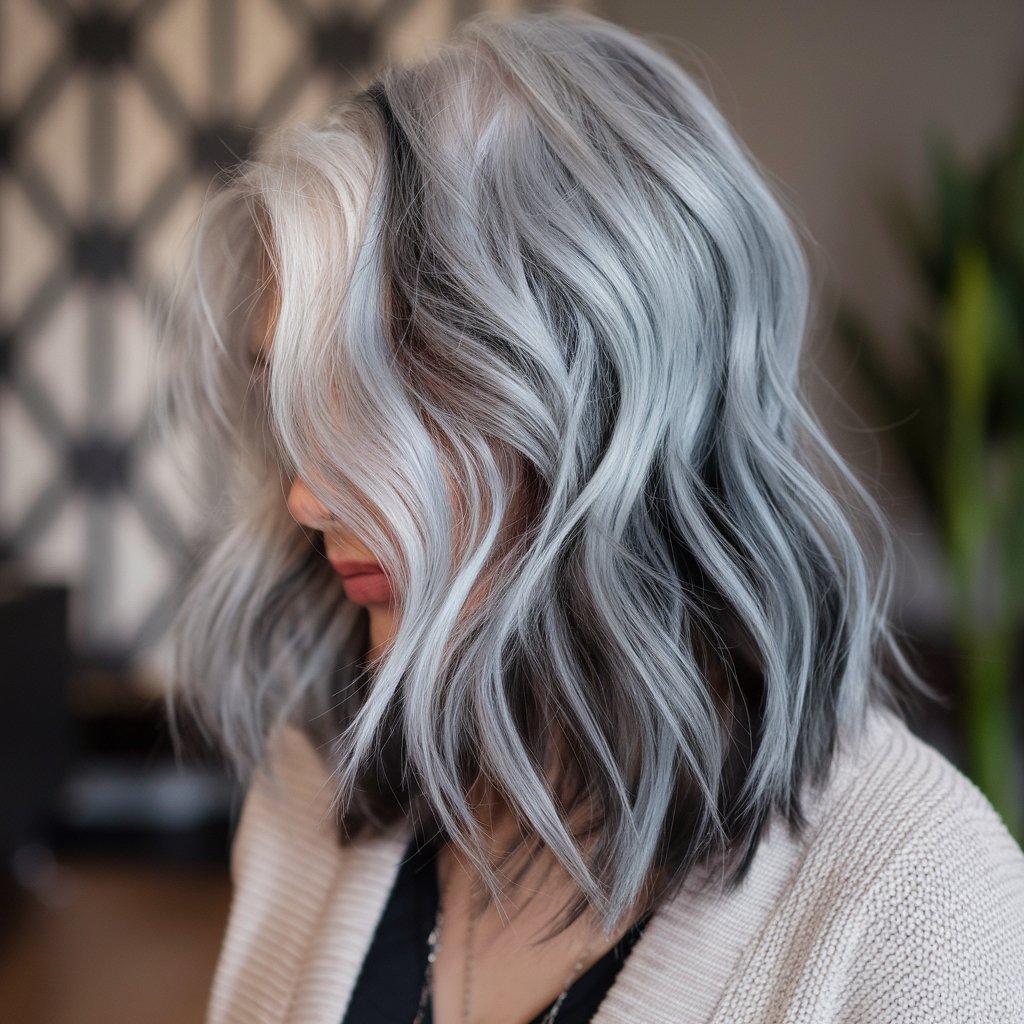
Highlighting offers multiple pathways for creating seamless gray integration, each with distinct advantages depending on your hair type and desired outcome. The key lies in selecting techniques that complement your natural gray pattern rather than competing with it.
Balayage for Natural-Looking Dimension
Balayage creates the most natural-looking gray blend because the hand-painted application mimics how hair naturally lightens. This technique allows highlights to flow organically through your hair, creating soft transitions that grow out beautifully without harsh demarcation lines. The strategic placement of highlights helps connect gray roots to the rest of your hair color seamlessly.
The freehand application means your colorist can customize the placement based on where your gray appears most prominently. Face-framing highlights can brighten your complexion while making gray less noticeable in the most visible areas. The graduated effect prevents the stripey appearance that can occur with traditional foil methods.
This technique requires less frequent touch-ups than other highlighting methods, making it ideal for women seeking lower maintenance options. The natural grow-out pattern means you can extend time between salon visits without looking unkempt.
Foil Highlights for Comprehensive Coverage
Traditional foil highlights provide more comprehensive coverage and consistent results throughout your hair. This method works particularly well when you need to address gray that appears uniformly across your head rather than in specific patches. Foils allow for precise color placement and better saturation ensuring every gray strand gets adequate coverage.
The controlled environment of foil processing also allows for more dramatic color changes when needed. If your gray has a yellow or brassy undertone, foil highlights can more effectively neutralize these unwanted tones while adding the desired lightness.
For women with resistant gray hair that doesn’t easily accept color, foil processing provides the heat and controlled environment necessary for proper color penetration. This method ensures more predictable and longer-lasting results.
Babylights for Subtle Enhancement
Babylights involve applying super-fine streaks of color to the topmost layer of hair, creating subtle brightness that makes gray less noticeable. This technique works best for women with minimal gray around the face or crown area who want gentle enhancement rather than dramatic change.
The micro-fine application creates a sun-kissed effect that adds luminosity without obvious color placement. This approach is particularly flattering for women with fine hair, as it adds visual texture and movement without weighing down the hair.
Babylights require skilled application but offer beautiful, understated results. The technique can be combined with other highlighting methods for comprehensive coverage that still maintains a natural appearance.
Herringbone Highlights for Complex Patterns
Herringbone highlights use a zigzag or v-shaped application pattern to create delicate blending between gray roots and existing hair color. This newer technique allows colorists to use both cool and warm highlight tones, depending on your natural hair color and gray undertones.
The varied application pattern creates more natural-looking results than straight-line highlighting methods. Some colorists even use two different highlight colors – one cool and one warm – to achieve more seamless blending when your pigmented hair and gray have different undertones.
This technique works particularly well for women with complex color patterns or multiple shades of gray throughout their hair. The varied placement ensures comprehensive coverage while maintaining organic-looking results.
Choosing the Right Highlight Shade
Selecting appropriate highlight colors is crucial for successful gray blending. You should aim for colors slightly lighter than your existing gray shade – typically platinum or ash blonde work well. The goal is creating enough contrast to camouflage gray while avoiding colors that look obviously artificial.
For women with warm undertones in their natural hair, honey, caramel, or beige blonde highlights prevent the hair from looking too ashy. Those with naturally cool undertones should choose icy platinum, ash blonde, or neutral beige shades that complement silver strands and prevent yellowing.
The highlight shade should fall within two levels of your base color to maintain natural-looking results. Extreme contrasts can make the highlighting obvious and require more frequent maintenance to look polished.
How to Choose the Right Lowlights for Your Gray Hair
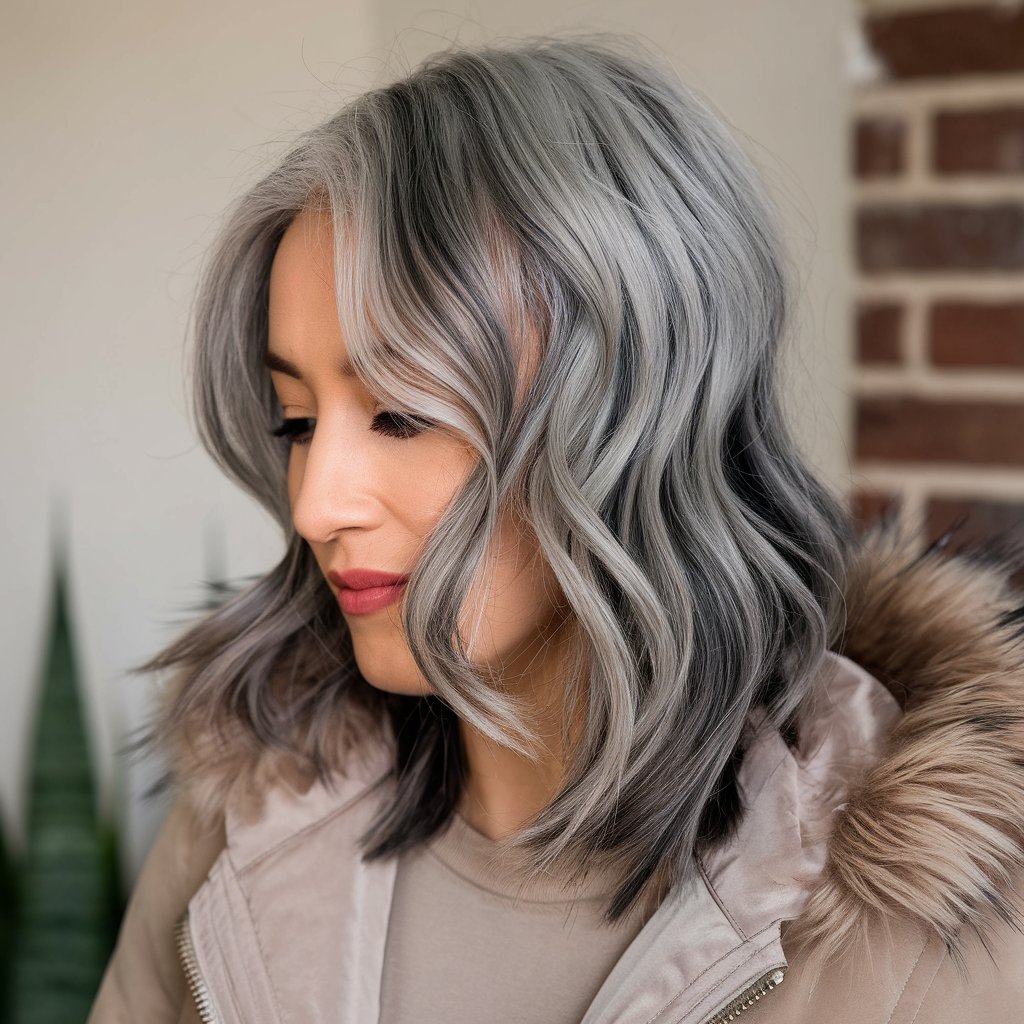
Lowlights add crucial depth and richness to gray blending, preventing the washed-out appearance that can occur with highlights alone. These darker tones create the contrast necessary for dimensional, youthful-looking hair.
Understanding When Lowlights Are Essential
Lowlights become particularly important when your natural gray is very light or when highlights alone make your hair appear too uniform. Adding deeper tones creates the natural variation that younger hair possesses, making the overall color appear more dynamic and textured. This technique prevents the flat, one-dimensional look that can age your appearance.
Women whose gray has developed a yellowish or dull cast also benefit significantly from lowlights. The deeper tones help neutralize unwanted brassiness while adding richness that makes the hair appear healthier and more vibrant.
Selecting Lowlight Colors for Different Base Tones
For dark hair, lowlights should incorporate rich shades like mahogany, espresso, and chestnut to make your base color more prominent. These deeper tones create beautiful contrast against gray strands while maintaining natural-looking results. Avoid going too dark, as excessive contrast can make the color appear artificial.
Medium brown hair benefits from lowlights in mocha, chocolate brown, or soft brunette shades. These colors add depth without creating harsh lines, helping to blend gray strands more seamlessly with your existing color.
Women with naturally lighter hair should choose lowlights that are only slightly darker than their base color. Soft taupe, silver-brown, or mushroom tones add dimension without creating obvious color placement.
Application Techniques for Natural Results
The placement of lowlights is just as important as the color selection. Random, organic placement creates more natural-looking results than uniform patterns. Your colorist should vary the thickness and spacing of lowlight sections to mimic how hair naturally darkens and lightens.
Concentrating lowlights near the nape of the neck and underneath layers adds depth that shows through when hair moves. This placement also helps frame the face and create the illusion of thicker, fuller hair.
Avoid placing lowlights too close to the hairline, as this can create an unflattering shadowy effect around the face. Instead, focus darker tones in areas where they’ll add dimension without overwhelming your features.
Balancing Highlights and Lowlights
The ratio of highlights to lowlights depends on your natural gray percentage and desired outcome. Women with significant gray coverage typically need more highlights than lowlights to achieve proper blending. A 60-40 ratio of highlights to lowlights often provides optimal results for most gray blending scenarios.
The key is creating enough variation to make individual gray strands less noticeable while maintaining overall color harmony. Too many highlights can make hair appear brassy, while excessive lowlights can make the color look muddy or dull.
Your colorist should adjust this ratio based on your skin tone, natural hair color, and lifestyle preferences. The goal is achieving a balanced look that enhances your natural features while requiring manageable maintenance.
Professional vs DIY Gray Blending Methods
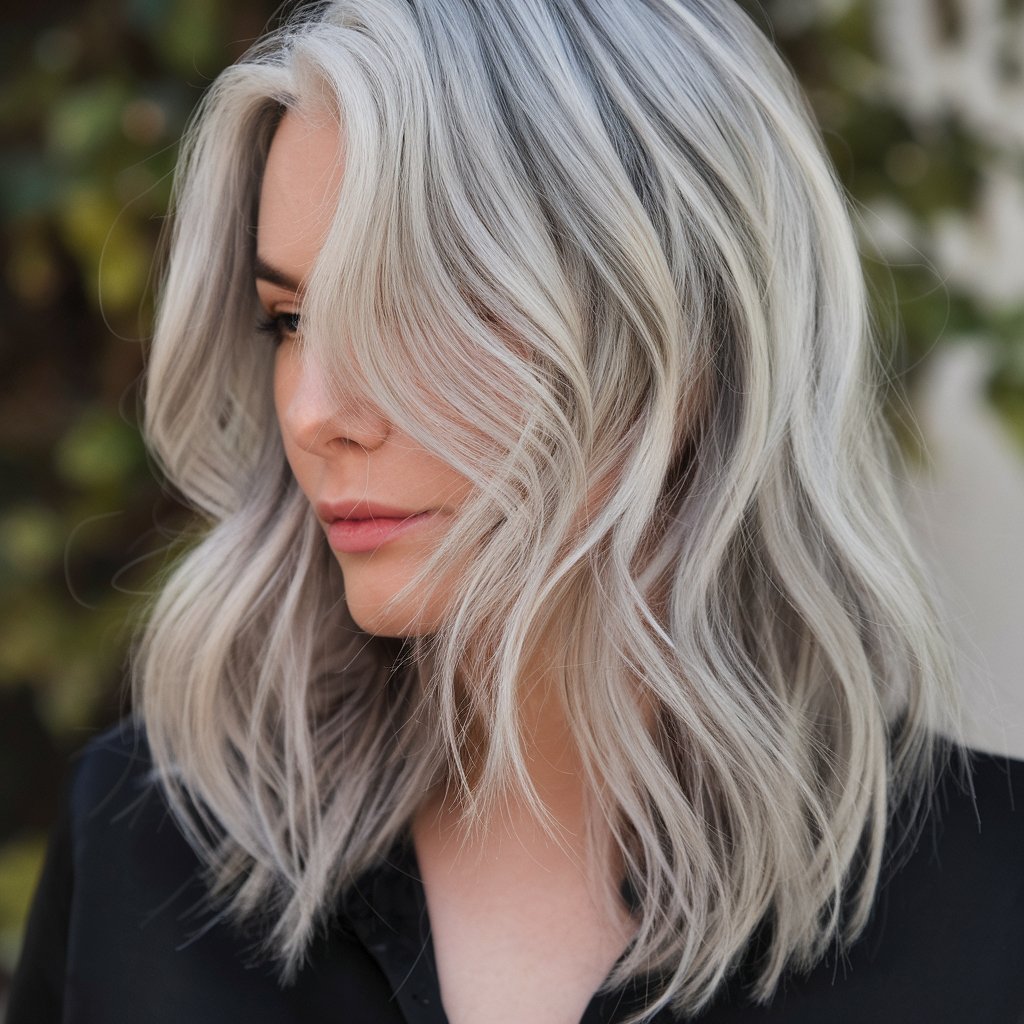
The complexity of gray blending makes professional application generally preferable, but certain techniques can be adapted for home use with proper preparation and realistic expectations.
When Professional Application Is Essential
Complex highlighting techniques like balayage, foilyage, and herringbone highlights require professional expertise to achieve natural-looking results. These methods involve precise color placement, timing, and toning that are difficult to replicate at home. Professional colorists also have access to higher-quality products and can customize formulations for your specific needs.
Women with more than 50% gray coverage should strongly consider professional application. The skill required to properly blend significant amounts of gray while maintaining hair health exceeds most home coloring capabilities. Professional colorists can also assess your hair’s condition and adjust techniques accordingly.
Previously colored hair presents additional challenges that professionals handle more effectively. If your hair has been chemically treated, highlighted, or permed, the interaction between existing color and new applications requires professional assessment to prevent damage or unwanted color results.
DIY Options for Subtle Enhancement
Home highlighting kits can work for women with minimal gray who want subtle enhancement rather than comprehensive coverage. Cap highlighting methods offer more control than painting techniques for inexperienced users. However, results will be more uniform and less natural-looking than professional applications.
Semi-permanent toners and glazes provide gentler options for at-home gray blending. These products deposit color without lifting, creating softer coverage that gradually fades over time. Regular applications help maintain color vibrancy between professional treatments.
Here are essential considerations for DIY gray blending:
Strand Testing: Always test color on a hidden section before full application to assess results and processing time.
Product Selection: Choose ammonia-free formulations designed specifically for gray coverage to minimize damage.
Timing Control: Gray hair processes differently, so monitor development carefully and don’t exceed recommended processing times.
Toning Applications: Use purple or blue-based toners to neutralize brassiness and maintain cool undertones.
Safety Considerations for Home Coloring
Gray hair’s altered texture makes it more susceptible to damage from chemical processes. Home applications should use lower-volume developers and shorter processing times than regular hair coloring. Deep conditioning treatments before and after coloring help maintain hair health.
Never attempt to lighten previously darkened hair at home, as this requires professional bleaching techniques that can severely damage hair if done incorrectly. Similarly, avoid trying to correct color mistakes yourself, as this often compounds the problem.
Cost-Benefit Analysis
Professional gray blending typically costs $150-400 depending on technique complexity and geographic location. While expensive initially, professional results last longer and require less frequent touch-ups than home applications. The superior color placement and customization also provide better long-term value.
DIY methods cost $15-50 per application but may require more frequent treatments to maintain results. Factor in potential corrective treatments needed if home coloring goes wrong, as professional color correction can cost significantly more than initial professional application.
Consider your skill level, available time, and desired results when making this decision. Many women find a combination approach works well – professional application initially, followed by home toning treatments to maintain color between salon visits.
Maintaining Your Gray Blending Results
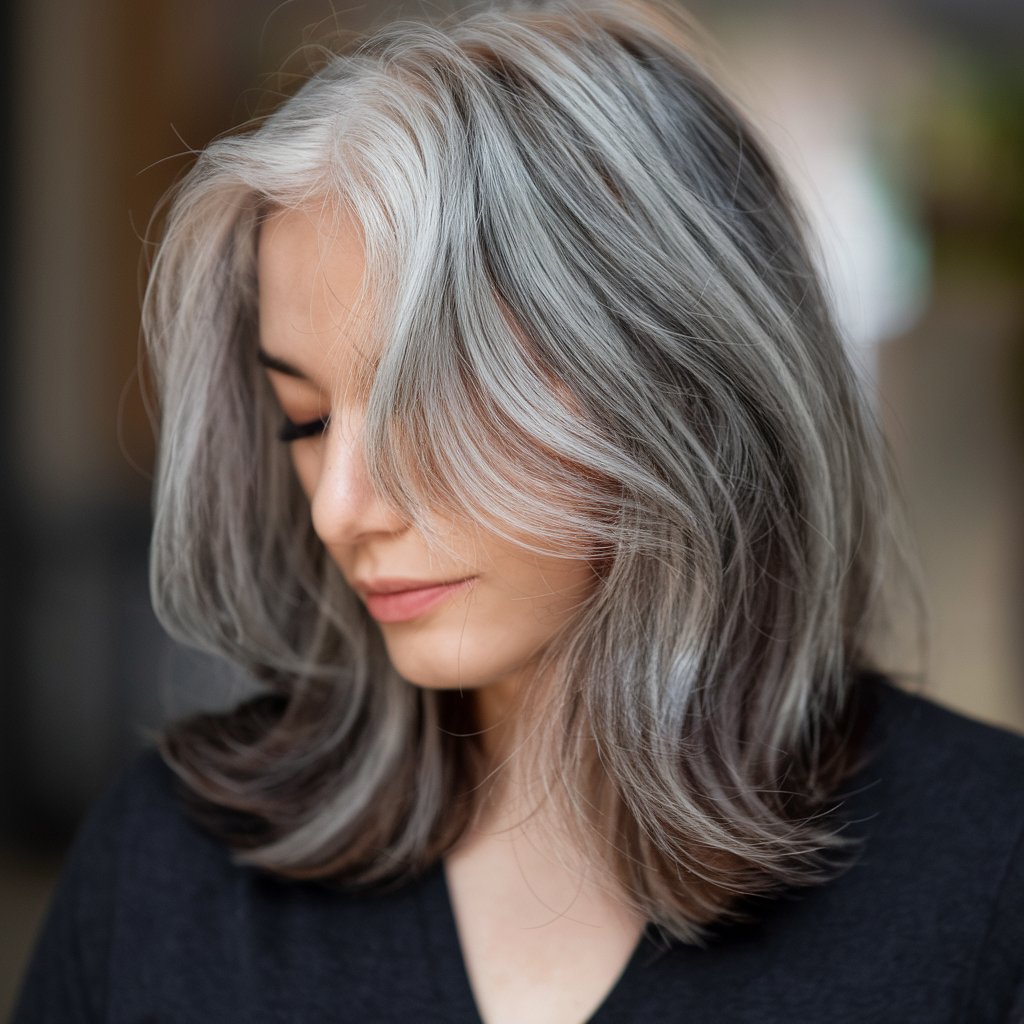
Proper maintenance determines how long your gray blending looks fresh and polished. The right care routine can extend time between salon visits while keeping your color vibrant and healthy-looking.
Essential Products for Color Maintenance
Purple shampoo becomes crucial for maintaining cool tones in highlighted hair. These products neutralize yellow and brassy tones that can develop over time, keeping your silver and blonde tones looking fresh. Use purple shampoo once or twice weekly, as overuse can deposit too much purple pigment and make hair look grayish.
Color-safe, sulfate-free shampoos protect your investment by preventing premature color fading. Sulfates strip color molecules from hair, causing highlights and lowlights to fade faster than necessary. Look for products specifically formulated for color-treated or gray hair.
Deep conditioning treatments help maintain hair health and color vibrancy. Gray hair tends to be drier and more porous than pigmented hair, making regular moisture treatments essential. Weekly deep conditioning masks help maintain softness and prevent color from looking dull or brittle.
Touch-Up Strategies Between Salon Visits
Root touch-up products can extend time between professional appointments by addressing the most noticeable new growth. Temporary root sprays, powders, and markers provide quick coverage for special occasions or between regular appointments. Choose products that match your blend rather than trying to match your original hair color exactly.
Semi-permanent glosses and toners help refresh color between highlighting appointments. These gentle treatments add shine and neutralize any unwanted tones without the commitment of permanent color. They’re particularly helpful for maintaining the cool tones essential to successful gray blending.
Face-framing touch-ups every 6-8 weeks can maintain a polished appearance between full highlighting sessions. Focus on the most visible areas around your hairline and part, leaving the rest of your hair for comprehensive treatment during regular appointments.
Timing Your Salon Appointments
Most gray blending maintenance follows a 8-12 week schedule, depending on your hair growth rate and gray percentage. Women with faster-growing hair or higher gray percentages may need more frequent touch-ups, while those with slower growth can extend time between appointments.
Schedule appointments based on your lifestyle and budget rather than trying to maintain perfect coverage at all times. The beauty of gray blending lies in its forgiving grow-out, so slight root visibility won’t ruin your overall appearance.
Plan appointments seasonally to coincide with your social calendar. Many women prefer fresh color before major events, holidays, or summer activities when hair will be more visible and photographed.
Protecting Your Color Investment
Heat styling tools can accelerate color fading, so use heat protectant products and lower temperature settings when possible. Gray hair is already more fragile than pigmented hair, making heat protection essential for maintaining both color and hair health.
Sun exposure can alter hair color and make highlights appear brassy or dull. Wear hats or use UV-protective hair products when spending extended time outdoors. This is particularly important for women with ash or platinum tones that are more susceptible to sun damage.
Swimming in chlorinated pools can significantly impact color-treated hair. Wet your hair with clean water before swimming and use leave-in conditioner to create a protective barrier. Rinse immediately after swimming and use clarifying shampoo if needed to remove chemical buildup.
Adjusting Your Routine Over Time
Your maintenance needs will change as your natural gray percentage increases. What works during early transition may need adjustment as you become more silver. Regular consultation with your colorist helps adapt your routine to your changing needs.
Consider gradually reducing highlight frequency and increasing lowlight applications as your gray becomes more prominent. This evolution allows for a natural transition while maintaining the dimensional color that keeps your hair looking intentional and polished.
Document what works best for your hair through photos and notes about products and timing. This information helps you communicate effectively with new stylists if needed and track what maintains your color most effectively.
Your Path to Beautiful Gray Blending Success
Gray blending transforms the often-dreaded transition to silver hair into an opportunity for sophisticated, dimensional color. The techniques covered here provide multiple pathways for achieving seamless integration between your natural gray and existing hair color, whether you choose professional application or selective DIY approaches.
The key to successful gray blending lies in working with your natural color rather than against it, using strategic highlighting and lowlighting to create harmony and depth. With proper technique selection, quality maintenance products, and realistic expectations about timing and upkeep, you can achieve beautiful results that enhance your natural beauty while requiring manageable maintenance. This approach allows you to embrace your silver strands gracefully while maintaining the polished, intentional appearance that keeps you feeling confident throughout your color journey.
Frequently Asked Questions
Q: How much gray hair do I need to have before considering gray blending?
A: Gray blending works best when you have 30-70% gray coverage. This technique is particularly effective for women with salt-and-pepper patterns or patchy gray distribution rather than uniform graying.
Q: Will gray blending damage my hair more than regular coloring?
A: Gray blending typically causes less damage than traditional single-process coloring because it uses lower-volume developers and doesn’t require complete color coverage. The techniques work with your natural hair rather than fighting against it.
Q: How often do I need salon appointments for gray blending maintenance?
A: Most women need touch-ups every 8-12 weeks, depending on hair growth rate and gray percentage. The technique grows out more gracefully than traditional coloring, allowing longer periods between appointments.
Q: Can I do gray blending at home successfully?
A: Simple techniques like toning and subtle highlighting can be done at home, but complex methods like balayage and herringbone highlights require professional application for natural-looking results. Women with more than 50% gray should seek professional treatment.
Q: What’s the difference between gray blending and regular highlights?
A: Gray blending uses specific color selection and placement techniques designed to integrate with silver strands, while regular highlights focus on adding brightness or changing overall hair color. Gray blending works with your natural graying process rather than covering it.
Q: How do I choose between warm and cool highlight tones?
A: Choose cool tones (ash, platinum) if your gray has naturally cool undertones and you want to prevent brassiness. Select warm tones (honey, caramel) if your natural hair has golden undertones and you want to maintain warmth in your overall color.
Q: Will my gray blending look obvious or natural?
A: Properly executed gray blending should look completely natural, mimicking how hair lightens and darkens in sunlight. The technique creates the kind of dimensional color that appears organic rather than artificial.
Q: What happens if I don’t like my gray blending results?
A: Professional colorists can adjust techniques, color placement, or tones to better suit your preferences. Most issues can be corrected with toning treatments or strategic additional highlighting or lowlighting.
Q: How much does professional gray blending typically cost?
A: Professional gray blending costs $150-400 depending on technique complexity, geographic location, and salon pricing. While expensive initially, results last longer than traditional coloring methods.
Q: Can gray blending work with previously colored hair?
A: Yes, but previously colored hair requires professional assessment to determine the best approach. Existing color affects how new highlights and lowlights will appear and may require additional steps for optimal results.

